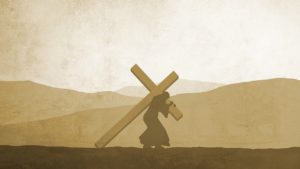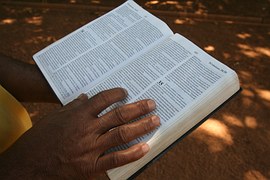 The week before Easter I like to read the Gospel accounts of the last week of Christ’s life on earth.
The week before Easter I like to read the Gospel accounts of the last week of Christ’s life on earth.
You can see how I do that here . . .
What the Bible Says about Jesus’ Last Week
This year I’m reading Mark’s account, chapters 11-16, a chapter each day. This is one way to walk with Christ all the way to the cross and the empty tomb.
Would you like to join me?
If you do this simple yet sanctifying Bible reading plan, let me know how it goes by leaving a comment below.
I am also reading J.C. Ryle’s commentary on Mark. He’s a gifted Bible teacher and offers many profound insights.
Here’s an excerpt from J.C. Ryle’s comments on Mark 11:1-11, the account of Christ’s “triumphal entry” into Jerusalem on Palm Sunday:
“He deliberately makes a public entry into Jerusalem at the head of His disciples. He voluntarily rides into the Holy City, surrounded by a vast multitude crying, ‘Hosanna!’ like King David returning to his palace in triumph (2 Samuel 19:40). All this too was done at a time when myriads of Jews were gathered out of every land to Jerusalem to keep the Passover. We may well believe that the Holy City rang with the tidings of our Lord’s arrival. It is probable there was not a house in Jerusalem in which the entry of the prophet of Nazareth was not known and talked of that night.
“These things should always be remembered in reading this portion of our Lord’s history. It is not for nothing that this entry into Jerusalem is four times related in the New Testament. It is evident that it is a scene in the earthly life of Jesus which Christians are intended to study with special attention . . .
“Let us observe, in the first place, how public our Lord purposely made the last act of his life. He came to Jerusalem to die, and He desired that all Jerusalem should know it. When He taught the deep things of the Spirit, He often spoke to none but His apostles. When He delivered His parables, He often addressed none but a multitude of poor and ignorant Galileans. When He worked His miracles, He was generally at Capernaum or in the land of Zebulon and Naphtali. But when the time came that He should die, He made a public entry into Jerusalem. He drew the attention of rulers, priests, elders, scribes, Greeks, and Romans to Himself. He knew that the most wonderful event that has ever happened in the world was about to take place. The eternal Son of God was about to suffer in the place of sinful men as the great sacrifice for sin was about to be offered up, the great Passover Lamb about to be slain, and the great atonement for the world’s sin about to be made. He therefore ordered it so that His death was eminently a public death. He overruled things in such a way that the eyes of all Jerusalem were fixed upon Him, and when He died, He died before many witnesses.
“Let us see here one more proof of the unspeakable importance of the death of Christ . . . Never let us forget that the crowning fact in all we know of Jesus Christ is His death upon the cross.
“From that death flows all our hopes. Without that death, we would have nothing solid beneath our feet. May we prize that death more and more every year we live; and in all our thoughts about Christ, may we rejoice in nothing so much as the great fact that He died for us!”
Many “amens!” to that . . . And many thanks for reading this post.
J.C. Ryle’s commentary on Mark is free on Amazon in Kindle format. To your copy, go to Amazon.com and search on this title:
Expository Thoughts on the Gospel of Mark








